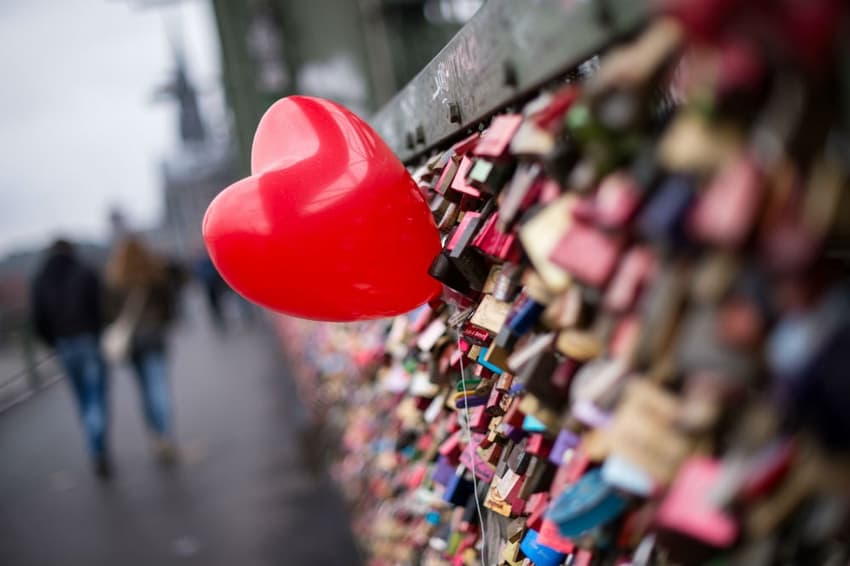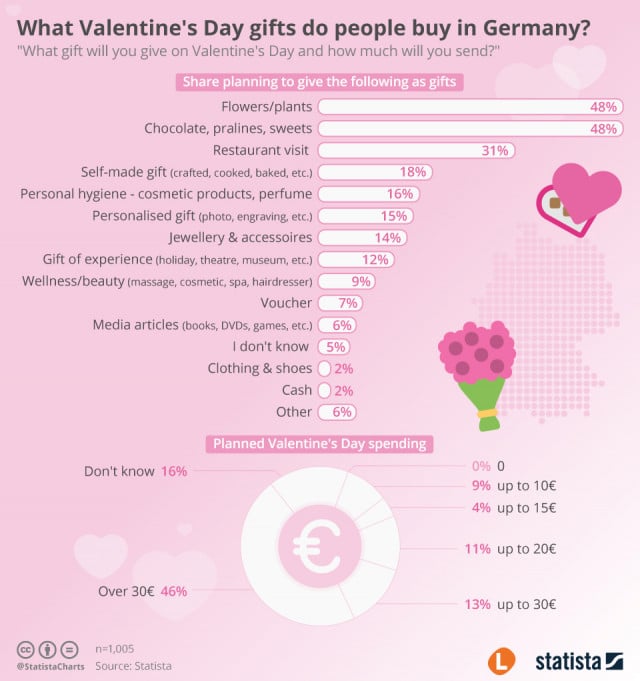Then and now: how Valentine's Day has blossomed in Germany

The annual day of love on February 14th isn't as big in Germany as it is in countries like the US. But since the 1950s Valentine's Day has grown increasingly popular across the country.
A survey published last week showed that half of Germans will be giving their partner a present on Valentinstag. One in five of them will be spending over €50 on their gift.
The survey, conducted by market research company Statista, also found that a larger percentage of men in Germany - 58.2 percent - plan on giving a gift on the day of romance. Only 50.8 percent of female respondents could say the same.
The findings from the survey also indicate that if you have a man as a partner - particularly between the ages of 25 and 44 - you’re much more likely to receive a token of love on February 14th. The chances of this lessen greatly if your male partner is older than 55. And if your partner is an elderly woman, you’ll most likely end up with nothing.
 A bouquet of roses at a florist in Hamburg. Photo: DPA
A bouquet of roses at a florist in Hamburg. Photo: DPA
But the day associated with boxes of chocolate and red roses hasn’t always been a thing in Deutschland.
It was only in the 1950s after the Second World War that sending out lovey-dovey cards and giving gifts first appeared. British and American soldiers stationed in Germany at the time are believed to have brought along some of their traditions with them, including Valentinstag.
The first Valentine’s Ball is said to have taken place in Nuremberg in 1950. The tradition slowly caught on over the next few decades. Whereas in the 1970s many Germans still had no idea what Valentine’s Day was, nowadays it’s gained a foothold across the country.
This can especially be seen in Germany's flower industry - which profits significantly from the annual holiday.
On Valentin'e Day in 2015, flower bouquets were about 7.7 percent more expensive than the annual average, Federal Statistical Office (Destatis) figures show.
That hasn't put Germans off buying though. Last year flower bouquet sales in the week leading up to Valentine’s Day were more than twice as high (just under €60 million) as the average week, according to market research company GfK.

And as the Statista chart above shows, gifting a partner flowers and sweets far surpasses presents like perfume, jewellery or lingerie.
As to the origins of the tradition itself, one of the most popular theories dates back to a mysterious saint named St. Valentine who suffered a brutal fate.
Legend has it that St. Valentine - a Roman physician and priest - was martyred around 269 AD. After being beheaded for the crime of marrying Christian couples, he became the patron saint of love, marriages and young people.
His feast day of February 14th was established in 496 AD.
As time passed, more and more romantic connotations came to be associated with the saint. By the Middle Ages, the cult of courtly love is believed to have spread across Europe; the tradition has been observed in countries like the UK and France since the late 14th century.
Whatever its origins, for many Germans today, Valentine’s Day just isn't a big deal. It has been criticized for being a day of commercialism and an 'imported' custom from other countries.
In the Berliner Morgenpost's list of 14 tips to make Valentine's Day in 2018 a success, one suggestion is to ignore the holiday.
"You don't have to like Valentine's Day. Besides, everyone knows that joy can be brought to loved ones at any time - no matter what day it is," the newspaper writes.
With DPA
Comments
See Also
A survey published last week showed that half of Germans will be giving their partner a present on Valentinstag. One in five of them will be spending over €50 on their gift.
The survey, conducted by market research company Statista, also found that a larger percentage of men in Germany - 58.2 percent - plan on giving a gift on the day of romance. Only 50.8 percent of female respondents could say the same.
The findings from the survey also indicate that if you have a man as a partner - particularly between the ages of 25 and 44 - you’re much more likely to receive a token of love on February 14th. The chances of this lessen greatly if your male partner is older than 55. And if your partner is an elderly woman, you’ll most likely end up with nothing.
 A bouquet of roses at a florist in Hamburg. Photo: DPA
A bouquet of roses at a florist in Hamburg. Photo: DPA
But the day associated with boxes of chocolate and red roses hasn’t always been a thing in Deutschland.
It was only in the 1950s after the Second World War that sending out lovey-dovey cards and giving gifts first appeared. British and American soldiers stationed in Germany at the time are believed to have brought along some of their traditions with them, including Valentinstag.
The first Valentine’s Ball is said to have taken place in Nuremberg in 1950. The tradition slowly caught on over the next few decades. Whereas in the 1970s many Germans still had no idea what Valentine’s Day was, nowadays it’s gained a foothold across the country.
This can especially be seen in Germany's flower industry - which profits significantly from the annual holiday.
On Valentin'e Day in 2015, flower bouquets were about 7.7 percent more expensive than the annual average, Federal Statistical Office (Destatis) figures show.
That hasn't put Germans off buying though. Last year flower bouquet sales in the week leading up to Valentine’s Day were more than twice as high (just under €60 million) as the average week, according to market research company GfK.

And as the Statista chart above shows, gifting a partner flowers and sweets far surpasses presents like perfume, jewellery or lingerie.
As to the origins of the tradition itself, one of the most popular theories dates back to a mysterious saint named St. Valentine who suffered a brutal fate.
Legend has it that St. Valentine - a Roman physician and priest - was martyred around 269 AD. After being beheaded for the crime of marrying Christian couples, he became the patron saint of love, marriages and young people.
His feast day of February 14th was established in 496 AD.
As time passed, more and more romantic connotations came to be associated with the saint. By the Middle Ages, the cult of courtly love is believed to have spread across Europe; the tradition has been observed in countries like the UK and France since the late 14th century.
Whatever its origins, for many Germans today, Valentine’s Day just isn't a big deal. It has been criticized for being a day of commercialism and an 'imported' custom from other countries.
In the Berliner Morgenpost's list of 14 tips to make Valentine's Day in 2018 a success, one suggestion is to ignore the holiday.
"You don't have to like Valentine's Day. Besides, everyone knows that joy can be brought to loved ones at any time - no matter what day it is," the newspaper writes.
With DPA
Join the conversation in our comments section below. Share your own views and experience and if you have a question or suggestion for our journalists then email us at [email protected].
Please keep comments civil, constructive and on topic – and make sure to read our terms of use before getting involved.
Please log in here to leave a comment.